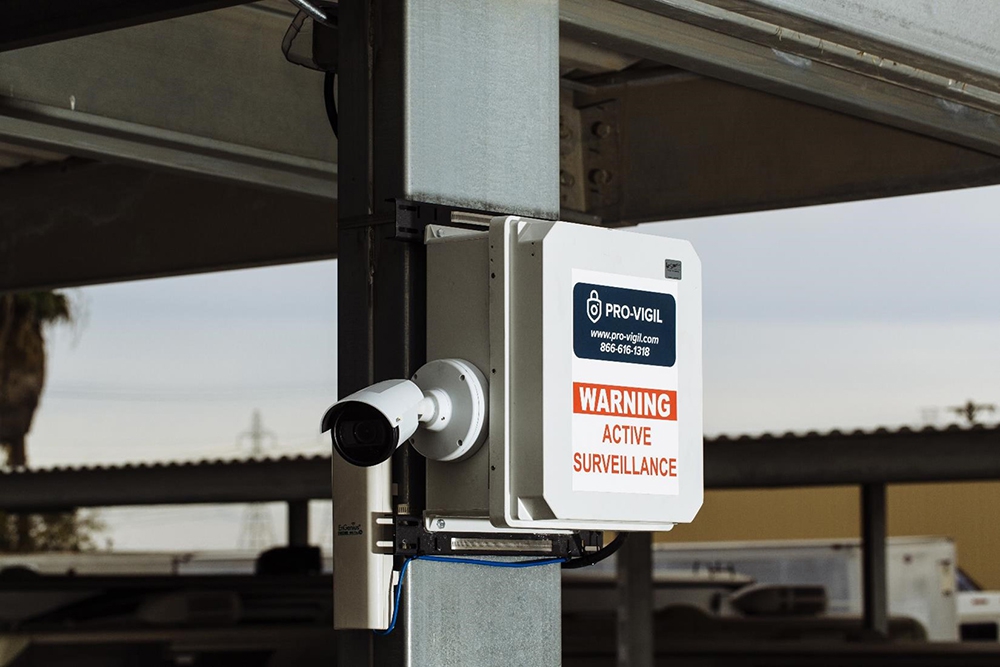Pro-Vigil survey – 28% of businesses saw rise in security incidents in 2022 Economic uncertainty, supply chain issues cited as main factors in increased number of physical security incidents

By Cory Harris, Editor
Updated 9:22 AM CST, Wed February 1, 2023

SAN ANTONIO, Texas—Pro-Vigil, a provider of remote video monitoring, management and crime deterrence solutions, has published its third annual “The State of Physical Security” research report.
The report revealed that amid ongoing supply chain issues and emerging economic uncertainty, businesses experienced a rise in physical security incidents in 2022. Yet many businesses have not updated their security strategies, despite believing these incidents will continue to rise in 2023.
 To better understand the physical security threats businesses are facing today, and what they are doing to combat them, Pro-Vigil polled 149 operations leaders across a range of industries including construction, dealerships (car/truck/boat/RV), retail, and manufacturing, among others.
To better understand the physical security threats businesses are facing today, and what they are doing to combat them, Pro-Vigil polled 149 operations leaders across a range of industries including construction, dealerships (car/truck/boat/RV), retail, and manufacturing, among others.
Jeremy White, founder of Pro-Vigil, told Security Systems News that with this being the third year that The State of Physical Security report was compiled, “We can really start to compare results as we start to add value and strength with some noticeable and measurable changes year over year, or not.
“I think the strength of the survey, as it builds year over year and we ask the same questions to similar folks, is it really shows us where business owners’ and managers’ heads are - what they’re thinking about the economy; what they’re thinking, or if they’re even thinking about security."
He continued, “As we’ve seen, there is more interest in security given some of the factors listed in the report. Year over year, this survey is adding more value by being able to measure it against the previous years and what the expectations are going forward, and then measuring what they thought versus what the outcomes end up being. It shows us where they’re going, what they’re thinking about, what they’re not preparing for, what they’re not thinking about and maybe they should be. That’s really what it is – where are their heads, what are they thinking, are they thinking risk is going up or down in terms of loss prevention. I think this survey is slowly gaining more and more value every year that we do it, for sure.”
Key Findings
Pro-Vigil’s survey showed that 28 percent of respondents saw an increase in physical security incidents in 2022, matching the result from the 2021 survey, and still up from just 20 percent of respondents in 2020.
Even with COVID-19 restrictions easing in 2022, economic uncertainty and supply chain issues were the top reasons why security incidents remained on the rise last year, according to the report.
White explained why these two factors emerged as the top reasons why there was an increase in physical security incidents in 2022.
“With supply chain, it’s supply and demand,” he said. “Supply is not there, it’s delayed, it’s behind, it’s driving up cost. Adding value to any of these materials increases the awareness by thieves and it makes it a greater target – from lumber on a construction site that’s much more valuable than it was three years ago due to supply and demand, to catalytic converters on auto dealership lots. I think that shows how much more precious these materials and products are now that they’re harder to get.”
Regarding economic uncertainty, White noted that “there’s just a direct correlation with an increase in crime. History has repeated itself as we saw from 2008-2010. With economic uncertainty now, we’re seeing the same types of levels of an increase in crime, and that’s what these managers who submitted their responses for this report are showing. From 20 percent in 2020 to almost 29 percent in 2022, it’s still up high – higher than normal. History has definitely repeated itself back from the 2008 era when we also saw a big increase in crime.”
Security Strategy
One surprising survey result was that 42 percent of respondents said they have not changed their security strategy. While the 2021 report revealed that nearly 57 percent of respondents had not updated their security strategies, 42 percent could still be considered a high rate in the face of these growing threats.
White explained why businesses remain stagnant in their protection efforts as they face this rise in physical security incidents.
“One side of it could be that they already have a security strategy in place. Not changing doesn’t mean they’re not doing anything,” he pointed out. “I think we could probably dig a little deeper into that next year and see what it is they are doing.
“Maybe they are confident in their solutions, so I kind of look at this in two ways. One, are they doing nothing, and insurance is all they’ve got and they feel that they’re secure enough, or are they in one of these industries that isn’t as affected as the others? We have to dig a little deeper into that one.”
The other side, according to White, is that security is “not always top of mind, even though we’re bringing it top of mind by polling these people. On a day-to-day basis, they’re probably more focused on their business, and security tends to be a reactive, kneejerk reaction to an event that has happened.”
White added that Pro-Vigil has “done everything we can to educate these industries. Remote video monitoring is relatively new - a couple of decades old, at most. It’s still not a mainstream security solution. You think guard, you think alarm system, but there are a number of other solutions that are still not common business practice solutions yet.”
Pro-Vigil’s report revealed that 41 percent of respondents are using intelligent remote video monitoring (RVM) for their businesses, as opposed to simple record and store video surveillance. However, 55 percent (up from 43 percent in 2021) said they do not use RVM for anything other than security surveillance, rather than expand their usage to include monitoring employee performance, worksite conditions and customer traffic flow.
When asked why companies continue to not look at the full ROI they can get out of RVMs, White noted that RVM first came out as a guard replacement or guard supplement, or as a blended solution complement to guard services.
“We still struggle to view RVM as something more than just a guard replacement or supplement,” he said. “It’s been difficult to educate customers on all the other solutions available. You already have the video system. ‘Yes, we have the intrusion detection, yes, we’re monitoring the site.’ But things like delivery confirmation, employee attendance, employee performance and productivity, store cleanliness, people counting – all these opportunities are there.
“Something that we’re doing in 2023 is really trying to educate the customers, and potential customers, on all the solutions available. It’s really business intelligence.”
Construction Industry
This year’s Pro-Vigil report focused on the construction industry, with 66 percent of respondents saying that they had experienced at least one security incident in 2022. However, 43 percent did not change their security strategy to meet this elevated threat.
“It’s been a challenge,” White said. “Budgets are tight. A commercial construction site may be operating on a 3 percent margin for a multi-million-dollar construction project. They can’t afford to lose much.
“As we reported in the survey, most of them experienced a delay in the project, which cost them money. What general contractors have to do is make a decision – do we gamble and do we hope that our losses are less than our security costs?
He continued. “What we found is they’re either proactive or reactive, and they will either wait until they’ve had a miss, so if they go three months without an incident, they’re playing a numbers game that they don’t have as much control over, or there are those that just go ahead and hire security in advance and know what their budget is, and their losses are minimal.
“The idea of ‘We don’t do anything until something happens’ is a very common play amongst managers because it’s their responsibility, once something happens, to come up with a solution to fix it. That is something that often happens in construction. We know it’s about three incidents a year – the report shows at least one, and that one is quite often three losses in a year. I would say solutions like RVM more than pay for themselves within the three losses in a year average that the construction industry generally sees.”
2023 Predictions
An overwhelming 91 percent of respondents – up from 87 percent in last year’s report - predicted that the number of physical security incidents will either stay the same or increase in 2023.
“It’s strange times, right?” White noted. “We’re reacting to unusual times, coming off of a pandemic into high inflation with economic uncertainty. I think that a lot of these managers, as they look at their security plans and business needs for the next year, it’s a moving target. It’s not a stable environment to be in.
“The smart ones are being very careful with how they’re planning and how far out they’re planning their needs for their business, including security. Yes, they know that theft is on the rise and supply chain issues are driving up material cost. We’re in year three of this situation, and managers are learning how to manage in this environment a little better. While they may not be planning five years out due to the economy and supply chain issues and theft on the rise, it is a moving target that they’re trying to thread a needle through, and yet their margins are likely down, revenues are down, and material costs are up, theft is up, so it’s a very challenging time.”
He added, “Comprehensive security plans are something that these companies are just not looking at as they should, which the study shows. Educating over time is what we’re trying to do, that they come in annually. We do quarterly business reviews with those larger customers, trying to make sure that we keep our thumb on the pulse of their business because it’s going to affect our business.”
With the survey results indicating that companies still do not do enough to face physical security challenges, especially in the area of updating their security strategies, White noted that it is going to be a “very slow process” to educate businesses on being more proactive and understanding that security needs change over time.
“Whether it’s annually, quarterly, getting them into some cadence of reviewing their security plan and what their needs are at that given time is critical,” he noted. “We will be doing what we can to educate them through statistics, through security plans that are eye openers – showing managers what they’re doing, what they’re not doing, what’s lacking.
“It’s slow adoption. Security is not sexy, technology is, and as security companies move more into technology, hopefully the adoption will improve as we’re offering more than just RVM, but other business intel that means more to them on a daily basis. I believe the adoption will increase. I think you’ll see in 2024, next year when we do this again, that those doing nothing, or those who haven’t planned to do anything, will increase even more.”
Surprises
When asked if there were any survey results that surprised him, White pointed out two things. “Even though those who thought that theft would be on the rise in 2023 only went up by a point over 2022 [29 percent from 28 percent], it was interesting that it stayed that high,” he noted. “That means the alertness is higher than it was two years ago. They’re predicting, they’re expecting, that means they’re talking about it, they’re thinking about it. I thought last year would have been our peak.”
Second, White cited the fact that the number of companies that installed cameras was the highest of any security measure that was taken in 2022. “Though they didn’t all sign up with remote video monitoring, the fact that video is kind of the go-to security measure over an alarm, a guard or a fence, speaks volumes for the direction that people are heading,” he said. “Once you’ve installed a camera, you’ve now enabled yourself to have RVM, to have other business intelligence, with AI dropped on top of it. I was surprised to see it that much higher than the other solutions that are available. I found that encouraging.”
Planning and Preparedness
White outlined what companies should do to ensure that they are prepared to handle any potential security threats, especially during the challenging economic times and continuing supply chain issues brought on by the COVID-19 pandemic.
“Placement of assets is critical, especially with supply chain issues and the cost of replacement,” he noted. “When you’re thinking about the security and safety of your assets and the investments you made, it really starts with the placement. I would say one - plan ahead. Where are you putting your assets? Two – do you have protection for the assets? Where are the vulnerabilities? It’s thinking and having a security plan in place, other than just relying on insurance.
“It’s planning and preparedness, and I think in the past, that’s what’s been lacking. Companies are getting smarter at placement and management of their assets.”
With the release of the third State of Physical Security report, White noted that the strength of the survey is “measuring the same things over and over again, but I do think diving into some of these areas, such as what are these companies doing in terms of their security strategy. If you say you’re not doing anything different, what is it that you are doing? I think that would be great to know.
“The other is I think it might be interesting to see businesses affected by industry by geography next year. We’ve taken a nice sample set across the U.S. Let’s see how these answers change, or look different, in different areas of the U.S. That may be interesting to see where they are affected, who’s adopting RVM in different geographies more than others. Is that speaking to more crime? Trends by geography may be interesting data to look at.”
White concluded, “It’s all about preparation and looking ahead, understanding what your risks are and what solutions are available. There are a number of us in the industry who are here to help, and part of what we do in the security industry is help devise plans and to protect these businesses.
“Most of them don’t have a security expert, especially in construction, in the auto dealership world and even in commercial real estate. That’s what those of us in the security field are here for – to help them devise a plan that helps them with their assets and any other security concerns they might have.”
To download Pro-Vigil’s research report, “The State of Physical Security Entering 2023,” please visit: https://pro-vigil.com/resources/2023-security-survey-report/.
Comments